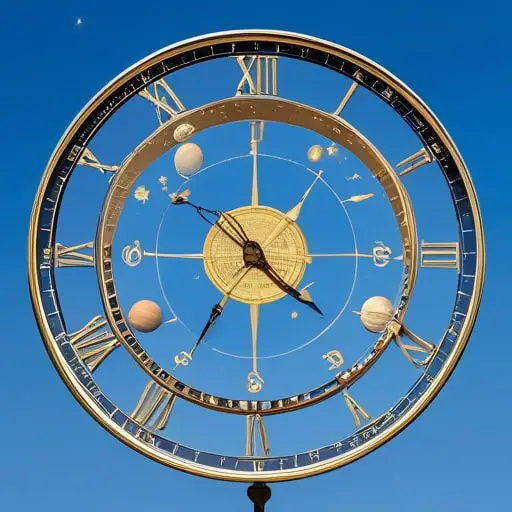Why Is Calculating Time On Pluto Challenging?
Ever wondered why calculating time on Pluto is such a daunting task? Well, brace yourself for a journey into the perplexing realm of celestial timekeeping.
As you embark on this exploration, prepare to unravel the intricate web of factors that make measuring time on Pluto a truly arduous endeavor.
From the enigmatic orbital characteristics to the mind-boggling effects of gravity, you will soon discover the myriad challenges that await those who dare to decipher the elusive ticking of the Plutonian clock.
So, get ready to delve into the captivating world of astronomical time and uncover the secrets that lie hidden in the depths of space.
Key Takeaways
- Pluto’s elliptical orbit and varying distance from the Sun cause temperature fluctuations and affect the length of its year.
- The slow rotation and lengthy days on Pluto lead to extreme temperature fluctuations and impact climate and weather patterns.
- Gravitational interactions with larger bodies and the resulting time dilation make accurate time measurement on Pluto challenging.
- Advancements in technology, including atomic clocks, are necessary to overcome the complexities of establishing a standard time system on Pluto.
Pluto’s Unique Orbital Characteristics
Pluto’s unique orbital characteristics make it an intriguing object in the solar system. Its elliptical orbit, tilted at an angle of 17.14 degrees, sets it apart from the other planets. This eccentric orbit causes Pluto to have a highly variable distance from the Sun, resulting in significant temperature fluctuations.
Furthermore, Pluto’s orbit is inclined relative to the plane of the solar system, causing it to cross Neptune’s orbit. This peculiar behavior leads to occasional interactions between the two objects.
Additionally, Pluto’s orbit isn’t perfectly circular, but rather elongated, which affects the length of its year.
These orbital characteristics make studying time on Pluto challenging, as its varying distance from the Sun and its interactions with Neptune significantly impact its rate of revolution around the Sun.
Slow Rotation and Lengthy Days on Pluto
With its unique orbital characteristics in mind, it becomes evident that the slow rotation and lengthy days on Pluto pose further complexities to our understanding of this distant celestial body. Here’s why:
- The slow rotation of Pluto means that its days are incredibly long, lasting for approximately 6.4 Earth days. Imagine experiencing daylight and darkness for such an extended period, where time seems to stretch on endlessly.
- The lengthy days on Pluto also affect the planet’s climate and weather patterns. With days lasting for such a long time, the temperature fluctuations become more extreme, with scorching heat during the day and freezing cold during the night.
- Additionally, the slow rotation of Pluto makes it challenging to determine its exact time and coordinate it with Earth’s time system. This discrepancy in time measurement creates further complexities in studying and understanding the dynamics of this distant world.
The Impact of Pluto’s Elliptical Orbit
The elliptical orbit of Pluto significantly impacts its position and distance from the Sun, leading to various consequences for the planet’s climate and overall dynamics.
Due to its elliptical orbit, Pluto’s distance from the Sun can vary greatly throughout its orbit. At its closest point, called perihelion, Pluto is about 29 astronomical units (AU) away from the Sun, while at its farthest point, called aphelion, it’s about 49 AU away. This large variation in distance results in significant changes in temperature on the planet’s surface.
As Pluto moves closer to the Sun during perihelion, its surface temperature increases, causing the icy surface to partially melt and creating temporary atmospheres. Conversely, during aphelion, the surface temperature drops drastically, causing the atmosphere to freeze and settle back onto the surface.
This constant freezing and melting cycle has a profound impact on Pluto’s climate and overall dynamics.
Variations in Sunlight and Temperature on Pluto
Variations in sunlight and temperature on Pluto have a significant impact on the planet’s climate and geological processes. The extreme distance of Pluto from the Sun, coupled with its highly elliptical orbit, results in dramatic fluctuations in sunlight and temperature throughout its year.
Here are three key effects of these variations:
- Seasonal Changes: As Pluto revolves around the Sun, its distance changes, causing significant variations in sunlight and temperature. This leads to distinct seasons on the dwarf planet, with summers being slightly warmer and brighter than winters.
- Atmospheric Dynamics: The variations in sunlight influence the behavior of Pluto’s thin atmosphere. Sunlight warms the surface, causing volatile ices to sublimate and create temporary atmospheres. As the sunlight diminishes, these atmospheres collapse, affecting the planet’s weather patterns.
- Geological Activity: The temperature variations on Pluto drive geological processes. As the temperature rises, the dwarf planet’s frozen nitrogen, methane, and carbon monoxide ices can become more active, leading to the formation of icy mountains, glaciers, and even cryovolcanoes.
Gravitational Interactions and Time Dilation
Gravitational interactions between Pluto and other celestial bodies cause time dilation, a phenomenon where time is experienced differently depending on the strength of the gravitational field. This means that the passage of time on Pluto isn’t the same as on Earth.
Due to its relatively small mass, the gravitational field on Pluto is weaker compared to larger celestial bodies like the Sun or Earth. As a result, time on Pluto moves at a slightly different pace. This time dilation effect can be observed through precise measurements and calculations.
Scientists must take into account the gravitational interactions and account for the variation in time when calculating the duration of events or comparing time on Pluto to time on Earth. Understanding these gravitational interactions is crucial for accurately determining and measuring time on Pluto.
Challenges in Establishing a Standard Time System
To address the complexities of establishing a standard time system on Pluto, one must consider the intricate effects of gravitational interactions and time dilation. These challenges arise due to the unique characteristics of the dwarf planet’s environment.
Here are three reasons why establishing a standard time system on Pluto is challenging:
- Gravitational interactions: Pluto’s gravitational field isn’t uniform, which leads to variations in time. The gravitational pull from its moon Charon and the uneven distribution of mass on Pluto itself create fluctuations in time measurement.
- Time dilation: According to Einstein’s theory of relativity, time moves differently in regions with varying gravitational fields. This means that time on Pluto would pass differently than on Earth, making it difficult to synchronize time between the two planets.
- Lack of reference points: Establishing a standard time system requires reference points, such as the rotation of the Earth. However, Pluto’s irregular rotation and its distance from Earth make it challenging to determine a consistent frame of reference.
Future Missions and Advancements in Timekeeping on Pluto
Future missions and advancements in timekeeping on Pluto will play a crucial role in overcoming the challenges associated with establishing a standard time system on the dwarf planet.
As technology continues to advance, scientists are developing more accurate methods to measure time on Pluto. One proposed mission involves sending a spacecraft equipped with atomic clocks to orbit Pluto, allowing for precise time measurements.
These advancements in timekeeping technology will enable scientists to better understand the complex rotation and orbital dynamics of Pluto.
By studying the planet’s movements and establishing a standard time system, scientists will be able to coordinate future missions and scientific experiments more effectively.
This won’t only enhance our understanding of Pluto but also contribute to the overall progress of space exploration and our sense of belonging in the vast universe.
Frequently Asked Questions
How Does Pluto’s Unique Orbital Characteristics Affect the Calculation of Time on the Planet?
Pluto’s unique orbital characteristics influence time calculation on the planet. Understanding how its orbit deviates from a perfect circle and the varying distance from the Sun allows for accurate measurement of time on Pluto.
What Are the Reasons Behind Pluto’s Slow Rotation and Lengthy Days, and How Does It Impact Timekeeping?
Pluto’s slow rotation and lengthy days are due to its unique orbital characteristics. This poses challenges in timekeeping because the length of a Plutonian day varies and is not synchronized with Earth’s 24-hour day.
How Does the Elliptical Orbit of Pluto Impact the Calculation of Time on the Planet?
The elliptical orbit of Pluto impacts time calculation on the planet by causing variations in its distance from the Sun. This affects the length of its year and the speed of its rotation, making timekeeping challenging.
What Are the Variations in Sunlight and Temperature on Pluto, and How Do They Pose Challenges in Determining the Accurate Time?
Determining time on Pluto is challenging due to variations in sunlight and temperature. These variations pose problems in accurately measuring time because they affect the planet’s rotation and the accuracy of clocks.
How Do Gravitational Interactions and Time Dilation Affect the Measurement of Time on Pluto?
Gravitational interactions and time dilation complicate time measurement on Pluto. These phenomena, like a complex dance between celestial bodies, make it tricky to accurately determine the flow of time in this distant world.
Conclusion
In conclusion, calculating time on Pluto presents numerous challenges due to its unique orbital characteristics and slow rotation.
The elliptical orbit of Pluto, along with variations in sunlight and temperature, further complicates the establishment of a standard time system.
Additionally, gravitational interactions and time dilation play a role in the accurate measurement of time on this distant dwarf planet.
However, with future missions and advancements in timekeeping, scientists may be able to unravel the mysteries of time on Pluto, shedding light on its enigmatic nature.











